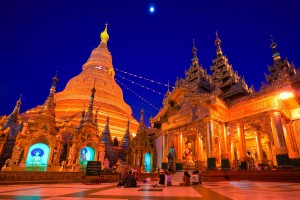
With total international arrivals of some 1 million for the very first time in 2012, Myanmar?s tourist industry shifts into higher gear with an expected increase of up to 50 percent in 2013. Especially, the organizing of the SEA Games pushes the numbers in December 2013, while in 2014 tourist arrival to Myanmar as the last frontier to discover will surely continue to rise. But compared to neighboring Thailand with its expected 26 million tourists this year, Myanmar is still in its infancy to attract mass tourism.
Instead, Union tourism minister U Htay Aung is banking on a strict formula of a responsible tourism policy and led the development of the impressive Myanmar Tourism Master Plan, where 38 strategic projects are singled out for implementation, covering 2013-2020 in line with the Government?s reform strategies and economic liberalization. The goal of this master plan is to maximize tourism?s contribution to national employment and income generation, while ensuring that the social and economic benefits of tourism are distributed equitably. Thus, tourism is used to make Myanmar a better place to live in.
Although Myanmar possesses diverse and extensive cultural, natural, and historic assets, it has only just begun to develop its enormous tourism potential. Covering an area of 676,577 square kilometers, the country is the second largest in ASEAN and its northern and southern borders extend some 2,100 kilometers from the snow-capped mountains of the Himalaya to the pristine Myeik archipelago in the Indian Ocean. Also, Myanmar boasts a youthful population of 60 million people. In 2012, per capita gross domestic product (GDP) was about US$900, the lowest in ASEAN.
As it works to promote economic growth and integration with ASEAN, Myanmar strongly supports regional co-operation in tourism and is an active member of the Greater Mekong Sub-region (GMS) Program and the Ayeyarwady-Chao Phraya-Mekong Economic Co-operation Strategy (ACMECS). These regional projects aim mainly to develop quality tourism products and services, strengthen human resources, and reduce barriers to travel.
While just recently four land cross-border checkpoints were upgraded for international tourists to enter Myanmar from Thailand, namely Tachileik-Mae Sot, Myawaddy-Mae Sot, Htee Khee-Sunaron, and Kawthoung-Ranong, overland entry was permitted to tourists from China and India with pre-arranged border passes. But most of the arrivals come by air to the gateways of Yangon, Mandalay, Bagan, and Naypyitaw, and last not least to Mawlamyain in the southern part of the country. According to the Ministry of Hotels and Tourism, the top four Asian source markets in 2013 were Thailand, Japan, South Korea and China, while the top three European source markets were France, UK, and Germany. Traveler types comprised of Foreign Individual Travelers (FIT), followed by business travelers, tour package travelers, and social visa holders.
Click here to read more.

